
Posidonius is a lunar impact crater that is located on the north-eastern edge of Mare Serenitatis, to the south of Lacus Somniorum. It was named after ancient Greek philosopher and geographer Posidonius of Apamea. The crater Chacornac is attached to the southeast rim, and to the north is Daniell.
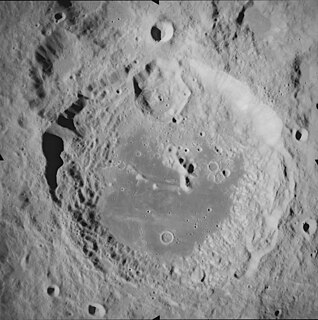
Aitken is a large lunar impact crater that lies on the far side of the Moon, named for Robert Grant Aitken, an American astronomer specializing in binary stellar systems. It is located to the southeast of the crater Heaviside, and north of the unusual formation Van de Graaff. Attached to the southwest rim is Vertregt. To the southeast is the smaller Bergstrand.

Carrel is a small lunar crater on the Mare Tranquillitatis. It has a somewhat distorted appearance, having a slight protruding bulge in the northwest rim. The interior is somewhat irregular, with ridges and some slumped material. This crater lies across a ridge in the surface of the mare.

Taruntius is a lunar impact crater on the northwestern edge of Mare Fecunditatis. It was named after ancient Roman philosopher, mathematician and astrologer Lucius Tarutius Firmanus. To the northwest is the lava-flooded crater Lawrence, and to the north lie the craters Watts and da Vinci.
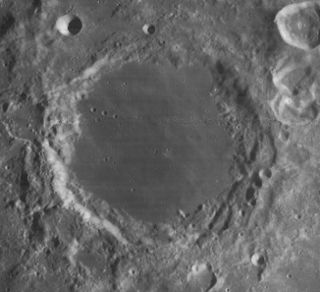
Endymion is a lunar impact crater that lies near the northeast limb of the Moon. It is located to the east of Mare Frigoris, and north of the Lacus Temporis. To the southwest is the somewhat smaller crater Atlas. Because of its location, Endymion has an oval appearance from foreshortening. Beyond the crater along the lunar limb is the Mare Humboldtianum.

Buys-Ballot is an oddly-shaped lunar impact crater that is located on the far side of the Moon. It lies just to the northwest of the small lunar mare named Lacus Luxuriae, and southeast of the crater Freundlich. Other nearby craters of note are Anderson to the southwest and Dante to the northeast.
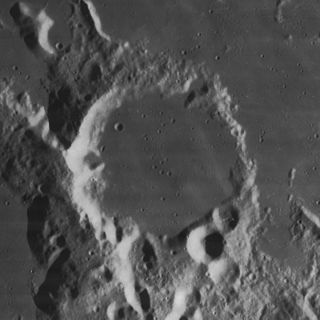
Capuanus is a lunar impact crater that lies along the southern edge of the Palus Epidemiarum. It was named after Italian astronomer F. Capuano di Manfredonia. The outer rim is eroded and indented by lesser crater impacts, with notches in the north, west, and southern parts of the rim. The interior floor has been resurfaced by basaltic lava, which is connected to the surrounding lunar mare by a narrow, crater-formed gap in the northern rim. Dotting the floor of the crater are a number of domes, which are believed to have formed through volcanic activity.
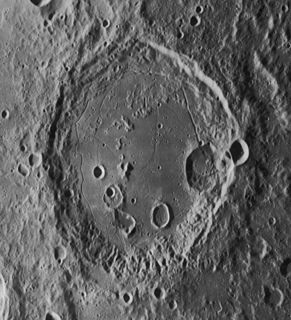
Gauss is a large lunar impact crater, named after Carl Friedrich Gauss, that is located near the northeastern limb of the Moon's near side. It belongs to a category of lunar formations called a walled plain, meaning that it has a diameter of at least 110 kilometers, with a somewhat sunken floor and little or no central massif. Due to its location, this crater appears considerably foreshortened when viewed from the Earth, and its visibility is affected by libration.

Mercurius is a lunar impact crater that is located in the northeastern part of the Moon. It lies to the northeast of the smaller crater Carrington, and west-northwest of Zeno. Just to the south is the small lunar mare named Lacus Spei, and to the west is the larger Lacus Temporis.

Crozier is a lunar impact crater that is located on the southwest edge of Mare Fecunditatis, a lunar mare in the eastern part of the Moon's near side. It lies to the east-northeast of the prominent crater Colombo, and southeast of the small crater Bellot.

Daubrée is a lunar impact crater that is located to the southwest of the Mare Serenitatis, just to the west-southwest of the crater Menelaus in the Montes Haemus range. The small lunar mare Lacus Hiemalis lies along the southwest rim of Daubrée. The crater was named after French geologist Gabriel A. Daubrée. It was previously designated Menelaus S.
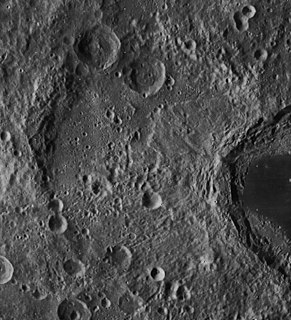
Fermi is a large lunar impact crater of the category named a walled plain. It was named after Italian-American physicist and Nobel laureate Enrico Fermi. It lies on the far side of the Moon and can not be viewed from the Earth. Thus this feature must be viewed from an orbiting spacecraft.
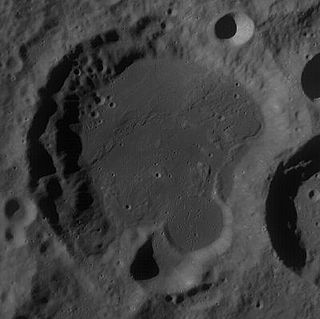
Crocco is a lunar impact crater that is located on the far side of the Moon from the Earth. It is located to the northeast of the huge walled plain Planck, and northwest of the equally huge Poincaré. Just to the north, within one crater diameter, is the crater Koch.

Mason is the remains of a lunar impact crater that lies in the northeastern part of the Moon. It is nearly attached to the eastern rim of the flooded crater Plana, and southeast of Bürg. Along the northern rim of Mason is the southern edge of the Lacus Mortis, a small lunar mare. To the south is the larger Lacus Somniorum.

Williams is the remnant of a lunar impact crater that lies to the south of the prominent crater Hercules, in the northeastern part of the Moon. The southern rim borders the Lacus Somniorum, a small lunar mare that extends to the south and west. To the southwest is the sharp-rimmed crater Grove.
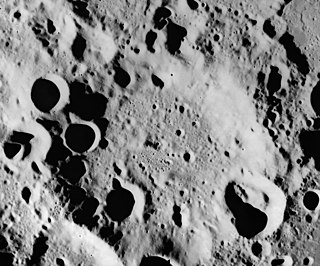
Titius is a lunar impact crater that is located on the Moon's far side, beyond the eastern limb. It lies to the west of the Lacus Solitudinis, a small lunar mare. Less than a crater diameter to the north east is the crater Bowditch, and farther to the southwest is Donner.
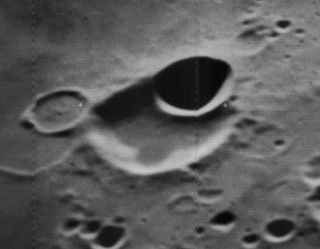
Resnik is a small lunar impact crater that is located within the interior of the huge walled plain Apollo, on the Moon's far side. Apollo is a double-ringed formation with a central floor that has been flooded with basaltic lava. Resnik is located at the northern edge of the dark area of the surface. It lies to the southwest of the smaller crater McAuliffe.

Koval'skiy is a crater on the far side of the Moon. It lies about one crater diameter to the southeast of the prominent Sklodowska, and to the north-northwest of Bowditch and Lacus Solitudinis, a small lunar mare.

Parkhurst is a heavily degraded lunar impact crater to the northeast of the Mare Australe on the far side of the Moon. To the north-northeast of Parkhurst is the crater Scaliger and to the southwest lies the dark-floored Gernsback. The small lunar mare named Lacus Solitudinis lies due north of Parkhurst.
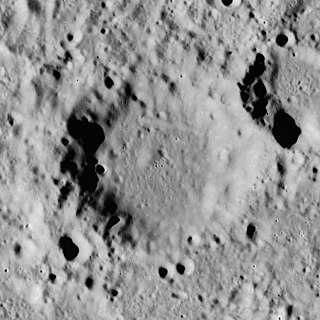
Perel'man is a worn impact crater that lies on the Moon's far side. It is located less than one crater diameter to the northwest of the prominent crater Scaliger. To the west-southwest is the elongated Bowditch. Southwest of Perel'man is a small lunar mare that has been named Lacus Solitudinis.























